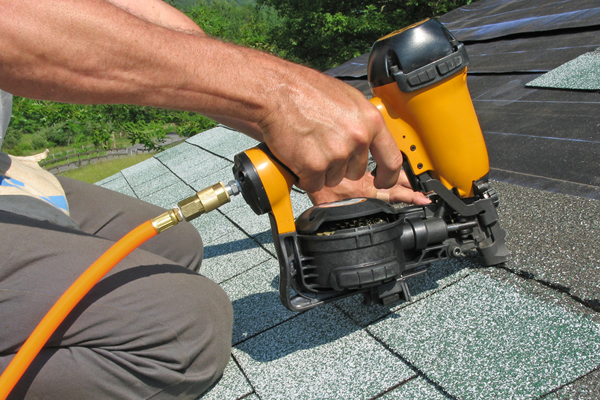4 Nail Gun Safety Tips Beyond the Basics
For most roofers, a nail gun is part of their everyday carry. Unfortunately, that same familiarity can make it easy for workers to forget that there's a risk of injury every time they carry a nail gun onto a roof.

One of the most common (and most commonly ignored) suggestions to maintain nail gun safety is to not use bump nailing. Now, we're not going to wade into that debate, other than to say that anything that makes it easier to fire fast is inherently less safe than something that takes multiple steps to nail. If you want a more in-depth exploration of the topic, you can read a summary from the National Institute for Occupational Safety and Health (NIOSH).
In the meantime, here are four nail gun safety tips to keep accidents rare.
Enforce Trigger Discipline
This bit of advice will be familiar to anyone who's used a firearm. Essentially, trigger discipline boils down to never placing your finger on the trigger until you're ready to fire a nail.
If your workers are bump nailing, then a finger on the trigger means their nail gun is ready to fire as soon as there's pressure on the nose tip — any accidental contact will fire a nail. For example, if a worker is holding their gun carelessly and brushes against another worker, you'll be making a panicked trip to the emergency room.
It's common to find workers with military or hunting experience on a jobsite. Using the phrase "trigger discipline" helps their previous training kick in and keep their current workspace safe.
Don't Fight the Recoil
Nail guns create a fair amount of kick-back, and many workers unconsciously fight it by pressing into the nailing material. This has two negative effects: First, that extra pressure can push the tip back into the material after firing. If the gun is set to bump the nail, it will immediately fire a second nail, but at an odder angle. It might strike the first nail or even clear the material entirely, sending that nail hurtling through the air.
The second effect of fighting recoil is that workers pressing too hard against the nailing surface can cause over-penetration, reducing the nail's fastening impact. This is true regardless of what kind of trigger is used, and may cause warranty issues down the line.
Understand Sequential Triggers
Roofing industry experts recommend installing sequential triggers on all nail guns. But what often gets skimmed over is the difference between full sequential and single sequential triggers.
Full sequential triggers won't fire unless the tip is pressed in before the trigger is pulled; both must be released before it can be fired again. Single sequential triggers only require that the trigger be released before re-firing. As long as the tip is depressed, your worker can fire again. This prevents bump nailing, but allows workers to slide the gun across a work surface while firing repeatedly. This seems efficient right up until a bit of debris tilts the gun at an angle. With the tip still depressed, the trigger is live and a nail can be fired clear of the work surface.
You can use whatever kind of trigger you're comfortable with, but be sure you understand the difference when buying a new gun or replacing a trigger.
A Bit of Shock and Awe
Make your next safety briefing memorable by showing a bratwurst to your crew, pointing out how it looks a lot like a human finger. Then, fire a nail through it.
That punctured brat is an unforgettable image, and will remind your crew how serious nail gun safety is for the rest of their roofing careers.